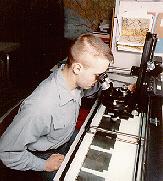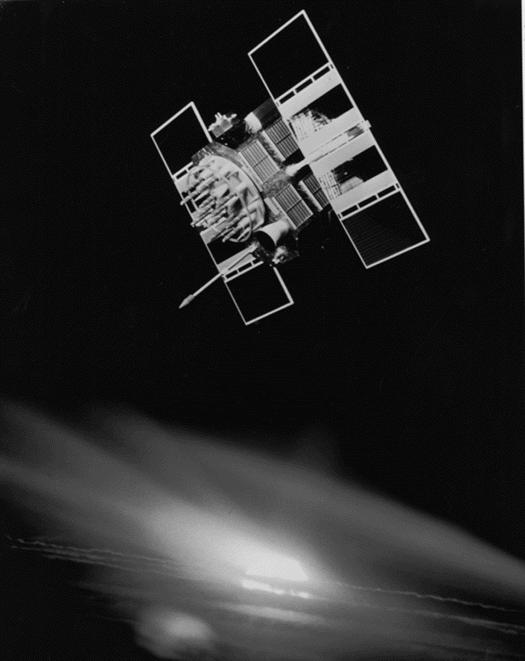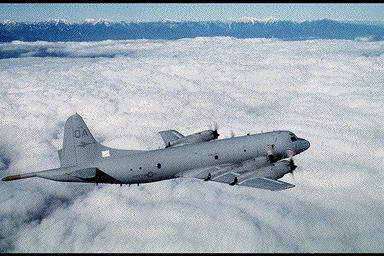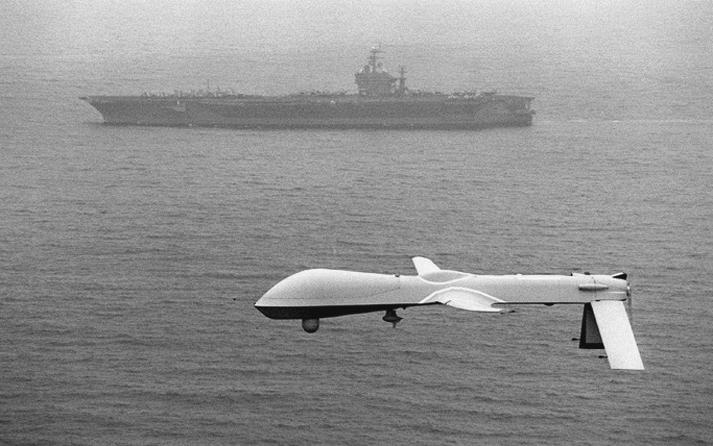AIRBORNE RECONNAISSANCE VISION
 Naval Aviation
systems are key contributors to the Defense Department's Integrated Airborne
Reconnaissance Strategy. The Navy and Marine Corps broad objective for
airborne reconnaissance is to achieve rapid full spectrum dominance, on
the battlefield or during operations other than war. Our specific reconnaissance
goal is to provide all warfighters with timely, useful, and sustained intelligence.
Naval Aviation
systems are key contributors to the Defense Department's Integrated Airborne
Reconnaissance Strategy. The Navy and Marine Corps broad objective for
airborne reconnaissance is to achieve rapid full spectrum dominance, on
the battlefield or during operations other than war. Our specific reconnaissance
goal is to provide all warfighters with timely, useful, and sustained intelligence.
The unique expeditionary capabilities of U.S. naval forces allows them
to bring early and extended reconnaissance capabilities to undeveloped
areas of operation. Wherever the United States has naval forces deployed,
it also has an in-place strategic intelligence collection capability that
supports the National Command Authority, the unified CINC, and the Joint
Task Force commander. At the tactical level, real-time airborne intelligence
provides a means to support early strikes and the precision engagement
of stationary and mobile enemy forces and facilities.
OPERATIONAL STRATEGY
 Naval Aviation's
strategy for providing airborne reconnaissance relies upon a systematic
approach, one that - in concert with space-based and other joint assets
- will meet U.S. warfighting needs through 2010. The desired endstate is
a force of manned and unmanned aircraft that is integrated into a broader
joint infrastructure and complies with the common format architecture mandated
by the Department of Defense. To achieve this force mix, we are assessing
the value and cost of existing analog systems while basing our procurement
plans on how well these systems perform on the joint digital battlefield.
Our ultimate goal is to achieve true, real-time sensor-to-planner intelligence
at the strategic/theater level, and sensor-to-shooter targeting at the
operational and tactical levels.
Naval Aviation's
strategy for providing airborne reconnaissance relies upon a systematic
approach, one that - in concert with space-based and other joint assets
- will meet U.S. warfighting needs through 2010. The desired endstate is
a force of manned and unmanned aircraft that is integrated into a broader
joint infrastructure and complies with the common format architecture mandated
by the Department of Defense. To achieve this force mix, we are assessing
the value and cost of existing analog systems while basing our procurement
plans on how well these systems perform on the joint digital battlefield.
Our ultimate goal is to achieve true, real-time sensor-to-planner intelligence
at the strategic/theater level, and sensor-to-shooter targeting at the
operational and tactical levels.
Navy airborne reconnaissance platforms are organic ISR assets that are
key to naval, and U.S., power projection. These aircraft must be able to
provide ISR data to a variety of weapon systems and platforms via the most
direct and expeditious means possible. The measure of effectiveness for
Naval Aviation's airborne reconnaissance platforms is the extent to which
they allow the prompt placement of the appropriate weapon on the correct
target. Consequently, they must be participants in joint information networks
in which intelligence and situational awareness data from all available
sources are fused and disseminated. The two primary joint communication
links Naval Aviation will use are JTIDS/Link 16 and the Tactical Information
Broadcast System/Information Broadcast System (TIBS/IBS). These joint information
"pipes" are being incorporated into naval reconnaissance aircraft.
MANNED TACTICAL AIRBORNE RECONNAISSANCE
Battle group and MAGTF commanders need the capability to immediately dispatch
tactical reconnaissance platforms to update the enemy's order of battle,
locate and track mobile targets, transmit target imagery, and provide timely
battle damage assessment. Stand-off, high endurance reconnaissance is provided
by EP-3E's  and
ASUW Improvement Program (AIP)-equipped P-3C's utilizing multiple sensors
including Electro-optic sensors and high-resolution SAR radars. All future
airborne reconnaissance systems must be compatible with the Common Imagery
Ground Service System (CIGSS), and current systems must become CIGSS capable
as they are upgraded. Naval Aviation meets this requirement with F-14 TARPS,
the only manned penetrating reconnaissance aircraft in the U.S. inventory.
and
ASUW Improvement Program (AIP)-equipped P-3C's utilizing multiple sensors
including Electro-optic sensors and high-resolution SAR radars. All future
airborne reconnaissance systems must be compatible with the Common Imagery
Ground Service System (CIGSS), and current systems must become CIGSS capable
as they are upgraded. Naval Aviation meets this requirement with F-14 TARPS,
the only manned penetrating reconnaissance aircraft in the U.S. inventory.
The Marine Corps Advanced Tactical Airborne Reconnaissance System (ATARS),
an internally-mounted, palletized system carried by the F/A 18D, will replace
the capabilities lost when the Marine Corps retired its RF-4B reconnaissance
aircraft in the early 1990s. The Navy will develop a reconnaissance system
for the F/A-18F (F/A-18F TACRECCE) that will replace the F-14 TARPS. The
Tomcat will continue to provide the only manned tactical reconnaissance
capability until the introduction of ATARS. The F-14's "Roadmap for the
Future" includes the incorporation of a digital imaging and data link capability
in 24 TARPS pods to provide battle group commanders and allied forces tactical
battlefield imagery in support of ongoing intelligence gathering requirements.
The TARPS digital imaging (DI) system will provide near real time imagery
for detection and identification of tactical targets and immediate threat
and bomb damage assessment. This unique, one-of-a-kind, capability deployed
with Tomcat squadron VF-32 in November 1996. Both systems will provide
Naval Aviation with armed, penetrating, rapid-response tactical reconnaissance
capability. They will provide real-time or near real-time, high resolution,
digital, day/night, all-weather and through-the-weather reconnaissance,
either by direct overflight or from stand-off ranges. The F/A-18D ATARS
will reach Marine Corps IOC in the second quarter of FY 1999, while the
Navy's F/A-18F TACRECCE will debut operationally around FY 2003-2004.
UNMANNED AERIAL VEHICLE TACTICAL RECONNAISSANCE
 The Naval Services
must be capable of receiving intelligence data via direct link from the
entire joint inventory of UAV variants, whether they are land- or sea-based.
The operational concepts of Forward... From the Sea and Operational
Maneuver from the Sea are based upon agility, the collection of
timely intelligence, and flexibility. The Department of the Navy can meet
these demands either with organic UAVs or by leveraging the capabilities
of other-service UAVs via direct data link. Organic UAVs must be capable
of landing with expeditionary forces, as well as operating with a variety
of naval warships. UAVs that operate in support of U.S. naval forces must
provide tactical reconnaissance out to the maximum ranges of the weapon
systems and aircraft of a carrier battle group or MAGTF.
The Naval Services
must be capable of receiving intelligence data via direct link from the
entire joint inventory of UAV variants, whether they are land- or sea-based.
The operational concepts of Forward... From the Sea and Operational
Maneuver from the Sea are based upon agility, the collection of
timely intelligence, and flexibility. The Department of the Navy can meet
these demands either with organic UAVs or by leveraging the capabilities
of other-service UAVs via direct data link. Organic UAVs must be capable
of landing with expeditionary forces, as well as operating with a variety
of naval warships. UAVs that operate in support of U.S. naval forces must
provide tactical reconnaissance out to the maximum ranges of the weapon
systems and aircraft of a carrier battle group or MAGTF.
Until a fully marinized Tactical UAV (TUAV) system is developed, the
retention of the Pioneer UAV - the Department of the Navy's only operational
UAV system - will remain a Naval Aviation priority. Capable of operating
from LPD-class amphibious ships and from shore locations, Pioneer has proven
extremely useful in supporting amphibious and expeditionary operations.
 In terms of new
UAV procurement, Naval Aviation's highest priority is the marinized TUAV
system. The ongoing TUAV Advanced Concept Technology Demonstration is designed
to meet the requirements of the Navy, Marine Corps, and the Army. Naval
Aviation supports the continuing research, development, and testing of
evolving vertical take-off and landing technologies, which may be incorporated
into the TUAV that supports the Navy and Marine Corps.
In terms of new
UAV procurement, Naval Aviation's highest priority is the marinized TUAV
system. The ongoing TUAV Advanced Concept Technology Demonstration is designed
to meet the requirements of the Navy, Marine Corps, and the Army. Naval
Aviation supports the continuing research, development, and testing of
evolving vertical take-off and landing technologies, which may be incorporated
into the TUAV that supports the Navy and Marine Corps.
Naval Aviation also remains committed to demonstrating Medium Altitude
Endurance (MAE) UAV technologies as part of an overall effort to refine
our UAV requirements and develop concepts of operations in which they are
featured. The Naval Strike and Air Warfare Center is addressing these requirements
and examining manned versus unmanned force mix issues.
Naval Aviation's interest in the High-Altitude Endurance (HAE) UAV system
is directed toward three areas. One involves the ability to task HAE UAV
missions, retask the aircraft's route of flight, and redirect its sensors
to support either joint or naval operations. The second area is the ability
to receive HAE sensor data in real-time, and the third is the ability to
process sensor data afloat and on shore.
In the area of UAV support and control, the Tactical Control Station
(TCS) is being designed to be a common link between all UAV systems. TCS
will be used to control the TUAV, while its secondary function will be
to receive Imagery Intelligence data from Endurance UAVs. TCS will be a
key element in the Naval Services' ability to receive and disseminate UAV
collected intelligence.


 In terms of new
UAV procurement, Naval Aviation's highest priority is the marinized TUAV
system. The ongoing TUAV Advanced Concept Technology Demonstration is designed
to meet the requirements of the Navy, Marine Corps, and the Army. Naval
Aviation supports the continuing research, development, and testing of
evolving vertical take-off and landing technologies, which may be incorporated
into the TUAV that supports the Navy and Marine Corps.
In terms of new
UAV procurement, Naval Aviation's highest priority is the marinized TUAV
system. The ongoing TUAV Advanced Concept Technology Demonstration is designed
to meet the requirements of the Navy, Marine Corps, and the Army. Naval
Aviation supports the continuing research, development, and testing of
evolving vertical take-off and landing technologies, which may be incorporated
into the TUAV that supports the Navy and Marine Corps.
 Naval Aviation
systems are key contributors to the Defense Department's Integrated Airborne
Reconnaissance Strategy. The Navy and Marine Corps broad objective for
airborne reconnaissance is to achieve rapid full spectrum dominance, on
the battlefield or during operations other than war. Our specific reconnaissance
goal is to provide all warfighters with timely, useful, and sustained intelligence.
Naval Aviation
systems are key contributors to the Defense Department's Integrated Airborne
Reconnaissance Strategy. The Navy and Marine Corps broad objective for
airborne reconnaissance is to achieve rapid full spectrum dominance, on
the battlefield or during operations other than war. Our specific reconnaissance
goal is to provide all warfighters with timely, useful, and sustained intelligence.
 Naval Aviation's
strategy for providing airborne reconnaissance relies upon a systematic
approach, one that - in concert with space-based and other joint assets
- will meet U.S. warfighting needs through 2010. The desired endstate is
a force of manned and unmanned aircraft that is integrated into a broader
joint infrastructure and complies with the common format architecture mandated
by the Department of Defense. To achieve this force mix, we are assessing
the value and cost of existing analog systems while basing our procurement
plans on how well these systems perform on the joint digital battlefield.
Our ultimate goal is to achieve true, real-time sensor-to-planner intelligence
at the strategic/theater level, and sensor-to-shooter targeting at the
operational and tactical levels.
Naval Aviation's
strategy for providing airborne reconnaissance relies upon a systematic
approach, one that - in concert with space-based and other joint assets
- will meet U.S. warfighting needs through 2010. The desired endstate is
a force of manned and unmanned aircraft that is integrated into a broader
joint infrastructure and complies with the common format architecture mandated
by the Department of Defense. To achieve this force mix, we are assessing
the value and cost of existing analog systems while basing our procurement
plans on how well these systems perform on the joint digital battlefield.
Our ultimate goal is to achieve true, real-time sensor-to-planner intelligence
at the strategic/theater level, and sensor-to-shooter targeting at the
operational and tactical levels.
 and
ASUW Improvement Program (AIP)-equipped P-3C's utilizing multiple sensors
including Electro-optic sensors and high-resolution SAR radars. All future
airborne reconnaissance systems must be compatible with the Common Imagery
Ground Service System (CIGSS), and current systems must become CIGSS capable
as they are upgraded. Naval Aviation meets this requirement with F-14 TARPS,
the only manned penetrating reconnaissance aircraft in the U.S. inventory.
and
ASUW Improvement Program (AIP)-equipped P-3C's utilizing multiple sensors
including Electro-optic sensors and high-resolution SAR radars. All future
airborne reconnaissance systems must be compatible with the Common Imagery
Ground Service System (CIGSS), and current systems must become CIGSS capable
as they are upgraded. Naval Aviation meets this requirement with F-14 TARPS,
the only manned penetrating reconnaissance aircraft in the U.S. inventory.
 The Naval Services
must be capable of receiving intelligence data via direct link from the
entire joint inventory of UAV variants, whether they are land- or sea-based.
The operational concepts of Forward... From the Sea and Operational
Maneuver from the Sea are based upon agility, the collection of
timely intelligence, and flexibility. The Department of the Navy can meet
these demands either with organic UAVs or by leveraging the capabilities
of other-service UAVs via direct data link. Organic UAVs must be capable
of landing with expeditionary forces, as well as operating with a variety
of naval warships. UAVs that operate in support of U.S. naval forces must
provide tactical reconnaissance out to the maximum ranges of the weapon
systems and aircraft of a carrier battle group or MAGTF.
The Naval Services
must be capable of receiving intelligence data via direct link from the
entire joint inventory of UAV variants, whether they are land- or sea-based.
The operational concepts of Forward... From the Sea and Operational
Maneuver from the Sea are based upon agility, the collection of
timely intelligence, and flexibility. The Department of the Navy can meet
these demands either with organic UAVs or by leveraging the capabilities
of other-service UAVs via direct data link. Organic UAVs must be capable
of landing with expeditionary forces, as well as operating with a variety
of naval warships. UAVs that operate in support of U.S. naval forces must
provide tactical reconnaissance out to the maximum ranges of the weapon
systems and aircraft of a carrier battle group or MAGTF.